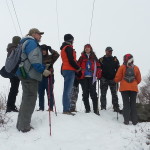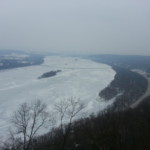- At the Bottom
- At the Top
- View From The Top
- The Susquehanna River
 Well, we finally had our Berry Mountain hike after canceling once, having no place to park and another winter storm threatening another cancellation. A few days prior to the hike I checked out the trailhead parking which was under 3 feet of snow. There were two men there plowing the road, so I batted my big brown eyes explaining my dilemma. They were wonderful and plowed the parking lot for us. That just left the threatening weather forecast to deal with. I said a little prayer and the storm never came. So the hike was a go!
Well, we finally had our Berry Mountain hike after canceling once, having no place to park and another winter storm threatening another cancellation. A few days prior to the hike I checked out the trailhead parking which was under 3 feet of snow. There were two men there plowing the road, so I batted my big brown eyes explaining my dilemma. They were wonderful and plowed the parking lot for us. That just left the threatening weather forecast to deal with. I said a little prayer and the storm never came. So the hike was a go!
We had a total of 10 hikers to start, but one missed us at the trailhead, ran, and caught up with us at the top in time to see the beautiful view and take in the surprise that was mentioned on Meet Up.
Once on the mountaintop we took a few moments to discuss hypothermia, a body temperature below 95 degrees F. The most important thing to know about hypothermia is how to prevent it in the first place.
Prevention:
- Adequate Protection from Exposure
- Extra dry clothes, fleece hat, gloves, waterproof shell
- Layer with synthetic or wool garments (cotton kills)
- Short breaks in sheltered areas
- Proper layering in route – know when to adjust your clothing (zip up/down, adding or removing clothing)
- Avoid sweating, use steady, reasonable pace to stay dry
- Proper Hydration and Nutrition
- Eat high energy foods and drink plenty of water
Hypothermia can happen in any type weather, even in the summer. That is why it is important to recognize the symptoms.
Symptoms:
- Mild to Moderate Hypothermia
- Shivering
- Stumbling, fumbling, slurred speech
- Changes in personality
- Body temperature below normal, but usually between 86 – 95 degrees F
- Severe Hypothermia
- Body temperature less than 86 degrees F
- No longer shivering
- Incoherence, confusion, apathy
- Unconsciousness may occur
- Irrational behavior – undressing, trying to locate a tight place to hide
- Weak slow pulse
- Blue tint to skin
- Dilated pupils
Once you are able to recognize the symptoms of hypothermia it is important to act quickly with proper treatment. If caught early enough the victim may be able to continue on there own.
Treatment:
- Mild to Moderate Hypothermia
- Get out of areas of exposure
- Replace wet base layers with dry ones
- Add additional layers, including insulation areas
- If victim is alert enough to hold a cup, give warm liquids. Sugary drinks are best. No alcohol, eat high energy snacks
- Moderate exercise if able
- Light a fire or stove for heat if feasible
- Monitor victim if conditions worsen or do not improve. Do not leave the victim alone.
- Place victim in sleeping bag well insulated from the ground with a space blanket or tarp around outside.
- Severe Hypothermia
- Follow above steps for Mild to Moderate Hypothermia
- Body to body contact – skin to skin in a sleeping bag if necessary
- Call 911 for rescue if able or send a group member with coordinates for rescue. If self-rescue by the group is an option do so slowly and smoothly to avoid jarring victim which may result in ventricular fibrillation.
- Do not give up on the victim, even if there is no pulse. Scientific techniques are resulting in hypothermic victims literally returning from the dead with warming techniques used in hospitals.
Hopefully this information will help you when planning outdoor activities.
We learned about hypothermia on Berry Mountain, but fortunately none of us became hypothermic.




